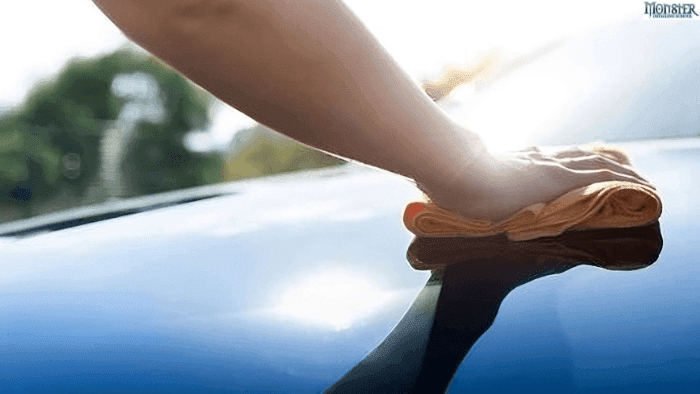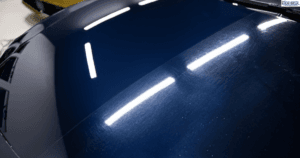Paint Protection Film (PPF) is one of the best ways to keep your car’s paint job looking fresh and new. Whether you just bought a new vehicle or want to extend the life of your current car’s exterior, PPF is a popular choice.
But how long does paint protection film really last? In this blog, we’ll look into everything you need to know about the longevity of PPF and how you can make it last even longer.
What is a Paint Protection Film?
It is a thin, transparent film of polyester to coat the surface of your car’s paint, generally called PPF. Its primary purpose is to protect the paint of your car from environmental elements like bugs, bird droppings, UV rays, and road debris.
It’s a nearly undetectable barrier that keeps the vehicle’s original finish, and more and more car owners are using it.
Related Blog: How to Apply Paint Protection Film (PPF)
Does Paint Protection Films Last Long?
The lifespan of paint protection film can vary depending on several factors such as the quality of the film, the installation process, and how well it’s maintained. On average, high-quality PPF can last anywhere between 5 to 10 years. Some premium brands may even offer warranties for up to 10 years, which indicates their confidence in the product’s durability.
But not every PPF is made equally. Cheaper films might not live as long; they usually only last three to five years. The length of the film is also significantly influenced by the environment your car is subjected to. The PPF may not last as long in cars that are regularly exposed to intense sunshine, severe weather, or a lot of road dirt.
Factors That Affect the Longevity of Paint Protection Film

1. Quality of the Film
The quality of the paint protection film you choose is the most important factor that determines its lifespan. High-quality films are engineered to withstand a variety of environmental factors, and they come with UV inhibitors that prevent the film from yellowing over time. Premium films are also more resistant to scratches, chips, and peeling compared to cheaper alternatives.
2. Installation
Proper installation is key to ensuring the longevity of your PPF. A professional installer will make sure the film is applied evenly without bubbles or creases, and they’ll ensure that it adheres properly to all parts of your vehicle. A poor installation can lead to premature peeling, bubbling, and even failure of the film, reducing its lifespan significantly.
3. Maintenance and Care
How well you care for your paint protection film plays a huge role in how long it lasts. Regular washing and proper cleaning methods will help maintain the clarity and effectiveness of the film. Avoid using harsh chemicals or abrasive tools, as these can scratch or damage the surface of the film. Keeping your car clean not only helps extend the life of the film but also keeps your vehicle looking its best.
4. Environmental Conditions
Cars that are exposed to extreme weather conditions, such as excessive heat, freezing temperatures, or heavy rain, will put more wear on the PPF. In areas with a lot of road salt or sand, the film may degrade faster. If your car is frequently exposed to the elements, it’s important to keep a closer eye on the condition of your PPF and have it inspected regularly.
5. Driving Habits
Your driving habits can also influence how long the paint protection film lasts. If you frequently drive on gravel roads, through construction zones, or at high speeds, your vehicle’s paint will be more exposed to damage from road dirt and other hazards. This can cause the film to wear down faster in those high-impact areas.
Related Blog: How to Wash a Car with Paint Protection Film?
How to Make Paint Protection Film Last Longer

While the average lifespan of PPF is 5 to 10 years, there are steps you can take to make it last even longer. Here are some tips to help you extend the life of your paint protection film:
1. Regular Cleaning
Regularly wash your vehicle with mild soap and water to remove dirt, grime, and other contaminants. Avoid using harsh chemicals or waxes, as these can damage the film over time. Using a microfiber cloth to gently clean the film will help prevent scratches and other surface damage.
2. Ceramic Coating Over PPF
Some car owners choose to apply a ceramic coating over their PPF for added protection. Ceramic coatings provide an extra layer of defense against environmental factors and can help prolong the life of your paint protection film. The ceramic coating also makes it easier to clean the vehicle, as it repels dirt and water more effectively.
Related Blog: Waxing vs Ceramic Coating: What Works on PPF?
3. Avoid Automatic Car Washes
Automatic car washes often use stiff brushes and abrasive materials that can damage PPF. It’s best to hand wash your car to ensure the film stays in good condition. If you do need to use a car wash, opt for a touchless wash that uses only water and soap to clean your vehicle.
4. Inspect the Film Regularly
Regularly inspect your paint protection film for any signs of wear, peeling, or damage. If you notice any issues, it’s a good idea to have them addressed right away. Most small issues can be repaired without having to replace the entire film, saving you time and money in the long run.
5. Park in a Garage or Shaded Area
To lessen UV exposure, put your automobile in a garage or other covered spot whenever you can. Regular exposure to direct sunlight may eventually cause the film to break down or turn yellow. Both the paint and the PPF will be better protected if you keep your automobile out of the sun.
Signs It’s Time to Replace Paint Protection Film

Even with proper care and maintenance, there will eventually come a time when your PPF needs to be replaced. Here are some signs that indicate it’s time for a new application:
1. Yellowing or Discoloration
One of the most common signs that PPF is reaching the end of its lifespan is yellowing or discoloration. This is often caused by prolonged UV exposure, and while it won’t necessarily affect the protection of the film, it can detract from the appearance of your car.
2. Peeling or Bubbling
If the edges of the film start to peel or if bubbles appear under the surface, it’s time to replace it. These issues can leave your car’s paint vulnerable to damage, and if left unchecked, the film may continue to deteriorate.
3. Scratches and Chips
Over time, the PPF can accumulate scratches, chips, and other surface damage. If these marks become too noticeable or if they compromise the film’s ability to protect the paint, a replacement may be necessary.
Related Blog: Paint Protection Film: Paint Safety & Adhesive Removal Guide
Conclusion
Paint protection film is a fantastic investment for anyone looking to preserve their car’s exterior and keep it looking new for years. On average, high quality PPF can last 5 to 10 years, but with the right care and maintenance, it may last even longer.
Regular cleaning, avoiding harsh chemicals, and protecting your vehicle from extreme weather are all ways to extend the life of your paint protection film.
If you’re interested in installing or replacing your PPF, Monster Detailing School offers professional services and complete PPF training to help you protect your vehicle’s paint. Contact us today to learn more about our PPF options and how we can keep your car looking its best!










